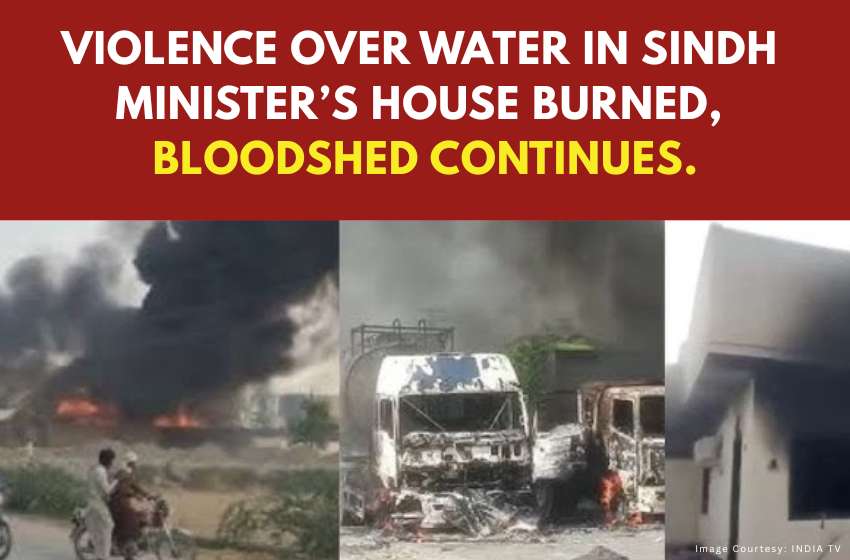
Water Crisis in Sindh: An In-Depth Analysis of Pakistan’s Growing Water Dispute
The current situation in Sindh is alarming. People are protesting, government buildings are on fire, and violence is spreading. Water rights have become a serious issue, pushing the region to the brink. Water is vital for Pakistan’s farming, economy, and peace. This article explores why this crisis happened, who is involved, and what can be done to fix it.
Understanding the Water Crisis in Sindh
Pakistan has several big rivers, but the Indus River is the most important. It supplies water for farming, drinking, and industry. The Indus Waters Treaty, signed by India and Pakistan, divides water sharing. But this treaty has faced many challenges over the years.
In the past, disputes over who gets how much water have caused tensions. Pakistan relies heavily on the Indus River and its tributaries. When water runs low, conflicts grow fiercer. The recent violence shows how fragile this system has become.
Recent Escalation of Water Disputes
Over the last few years, water flow in the Indus has decreased dramatically. This is partly due to less rainfall, climate change, and political decisions. People in Sindh are suffering because they get less water for farming and drinking.
In recent weeks, protests turned violent. People set fire to government buildings, attacked police, and destroyed trucks. The water shortage is no longer just an inconvenience; it’s a crisis. Reports show water levels in Sindh have dropped by over 50%, adding to hunger and poverty.
Key Stakeholders and Their Interests
The Pakistani government controls most water decisions. But provinces like Punjab and Sindh have their own interests. Punjab benefits from building canals on the Indus to grow crops. Sindh, which depends on the river, fears losing its water. Farmers and local communities are caught in the middle, suffering the consequences.
Core Causes and Weaknesses of Pakistan’s Water Management Structural and Environmental Challenges
Climate change has made the water situation worse. Rainfall has decreased, and droughts are more common. Desert areas like Thar and Cholistan are expanding.
Pakistan’s water infrastructure is old and poorly maintained. Dams, canals, and storage tanks are not enough to handle current needs. Many water projects are incomplete or outdated, worsening shortages.
Political and Administrative Failures
Pakistan’s water system is split between federal and provincial authorities. This lack of coordination leads to mismanagement. Corruption and favouritism often divert water away from those who need it most. Without clear plans, the crisis deepens.
Regional Tensions and Geopolitical Factors
India-Pakistan relations affect water sharing. When India suspended the Indus Waters Treaty, Pakistan’s water security took a hit. India builds dams and diverts water that flows to Pakistan, fueling mistrust.
Projects like the Cholsitan Canal aim to divert water to arid regions. Pakistan sees these moves as threats. They threaten to reduce water flow, leading to angry protests and potential violence.
The Water Dispute: Punjab vs Sindh Punjab’s Perspective and Strategies
Punjab’s government wants to build large canals on the Indus River. Their goal is to irrigate more land and boost crop production. They believe that controlling more water will help their farmers prosper.
Punjab claims this is necessary for their development. But they also know it will take water away from Sindh, raising fears of water shortages there.
Sindh’s Response and Concerns
Sindh’s farmers and communities are very worried. They depend on water from the Indus for their crops and daily lives. When water is diverted, their fields dry up, and livelihoods vanish.
People in Sindh have protested fiercely. They resist projects like the Indus Canal, fearing they will be left without water. Violent clashes have broken out, with protesters torching government buildings and attacking police.
Broader Implications for Pakistan
The crisis could push Sindh towards independence or more autonomy. If their water needs aren’t met, they may decide to break away from Pakistan. This threat is real because water is critical for survival.
This situation also tests Pakistan’s unity. The military and political leaders are worried. If the crisis worsens, it could lead to chaos, weaken the state’s authority, or even spark regional conflict.
International and Regional Implications
Role of India in the Water Dispute
India’s actions directly affect Pakistan’s water supply. When India suspended parts of the Indus Waters Treaty, Pakistan’s worries increased. Dams built on the Indian side reduce water flow to Pakistan.
This move by India has caused tension. Pakistan blames India for worsening their water problem and fears it’s a tactic to weaken Pakistan’s economy and military.
Water Crisis as a Geopolitical Tool
Water can be used as a weapon in regional disputes. Controlling or diverting water affects the entire country. Countries might use water to pressure each other, leading to conflicts.
Global Response and Humanitarian Concerns
International groups, including the United Nations, are paying attention. Millions of people in Sindh face water shortages, hunger, and health issues. Their plight needs urgent help.
Humanitarian agencies warn that if Pakistan’s water problems aren’t solved soon, the region could face a large-scale crisis with refugees, disease, and unrest.
Solutions and Future Outlook
Immediate Measures
Pakistan needs to modernize its water infrastructure fast. Fixing dams, canals, and storage tanks can help. Promoting rainwater harvesting and groundwater recharge is also critical. New water-sharing agreements should be negotiated fairly.
Long-term Strategies
The country must develop sustainable policies. Regional cooperation among provinces can reduce conflicts. Investing in climate-resistant infrastructure will prepare Pakistan for future changes.
Role of India and the International Community
India and other neighbours should cooperate to find peaceful solutions. International organizations can mediate, monitor, and encourage fair water use. Sharing knowledge and resources helps both sides.
Conclusion
The water crisis in Pakistan, especially in Sindh, is deeply serious. It reflects poor management, regional conflicts, and environmental challenges. Without fair and smart solutions, the situation may get worse. The country needs urgent reforms and regional cooperation to secure its future. Only then can Pakistan hope to avoid unrest, break the cycle of violence, and build stability around its water needs. The world must watch this crisis closely and support efforts to keep water flowing peacefully.
Disclaimer: This post was written by our team after researching many news sources and articles. These are not our personal thoughts or opinions.




